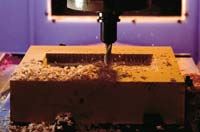Fast, Low-Cost Way to Make Short-Run Molds for Thermoforming
A new rapid manufacturing method for prototype thermoforming tools developed by Vantage Tool and Engineering (VTE) of Fort Wayne, Ind., generates high-quality short-run tooling in half the time and for half the cost of an aluminum production mold. VTE’s low-cost molds have proven useful for up to 500 molding cycles. Previous materials used for prototype or short-run thermoform tooling, such as epoxy or wood, reportedly are less durable and less able to provide highly detailed parts.
VTE is apparently the first maker of thermoforming molds to take advantage of Ren Shape modeling boards from Vantico Inc., Ren Shape Tooling Systems (formerly the Performance Polymers Div. of Ciba Specialty Chemicals) in East Lansing, Mich. Made from polyurethane and proprietary fillers, Ren Shape modeling boards have been used in injection molding and metal casting to machine dimensionally stable models, fixtures, foundry patterns, and tooling that have high accuracy and precise part definition.
Ample track record
VTE produces thermoforming molds for deep-draw parts as well as food trays, bowls, and other highly contoured containers from PP, PE, PS, and polycarbonate. The firm has been working with Ren Shape for more than two years to produce mold cavities for forming both heavy-gauge sheet (up to 3/16 in.) and thin films.VTE uses the Ren Shape Type 450 board (one of a family of products with a range properties), which has sufficient strength and heat resistance to withstand numerous thermoforming cycles. It has a glass-transition temperature of 205 F, Shore hardness of 65D, and tensile strength of 2300 psi.
The 4-in.-thick boards come in sizes of 16 x 60 in. VTE uses Vantico’s Ren Weld 103 adhesive to join several boards into a solid block that VTE can then machine into deep-draw molds using its standard three-axis CNC milling equipment and tool bits. VTE has made Ren Shape cavities with up to 24-in. depth of draw.
“The board helps us reduce delivery times and costs on initial parts while hard tooling is being made,” says VTE general manager Sam Geiger. “We can make a cavity for a heavy-gauge application in three days versus two-weeks for an aluminum tool. And we did it cheaper due to the shorter manufacturing time.” VTE built a package of 15 prototype molds in a two-week period for one customer and says it can make a mold in as little as a day. “If it’s a small mold, say 12 x 12 in., and we have the specifications in the morning, we can have the cavity done that evening,” Geiger claims.
Easy to machine
“It’s a lot faster to machine,” Geiger. “You don’t have to polish it. When it comes off the machine, it’s done. We achieve the same high level of detail as with an aluminum tool.”
On the other hand, VTE says it took a lot of experience working with the Ren Shape material to learn how to produce tools properly and to recognize its limitations in certain applications. When making mold blocks of Ren Shape, Geiger says that “accurate measuring and weighing of the adhesive components is the key to attaining strong bond lines and proper joining.” VTE clamps the boards for 48 hr to let the adhesive cure adequately. “During testing, we’ve found that the board shears before the bond line breaks,” Geiger notes.
VTE also developed particular practices for machining Ren Shape. Machining typically begins with a 0.5-in.-deep cut, followed by cuts 1-in. and then 1.5-in. deep. Two-fluted, hardened-steel ball-end mills are used to machine the board at 3500 rpm and 120 in./min for roughing. Finishing cuts are made with a 0.25-in. tapered, fluted-end mills at 4500-5000 rpm and 150-160 in./min., using a 0.007-in. stepover to produce mold surfaces that require no secondary finishing. The finished cavity is inserted into a standard aluminum mold base.
Not a panacea
“Thin-wall parts that run at temperatures up to 450 F are typically the most difficult to form because the Ren Shape mold holds in the heat. When we’re running multiple parts, heat build-up has the potential to damage the mold surface. So we reduce the cycle speed to allow the heat to dissipate,” says Geiger. With thin-gauge products, he says, “We may get only one or two hits off the Ren Shape tool, then we have to let it cool down. With thin gauges we may run only 50 cycles total.”
On the other hand, the heat trapped in the Ren Shape tool can help provide good part definition with heavy-gauge sheet. Because the cycles are slower, Ren Shape molds have run up to 500 heavy-gauge parts without problems. “We specialize in Ren Shape tooling for prototyping heavy-gauge parts,” notes Geiger. “One of our biggest projects was tooling for sample-part production of sleeper cabs for 2000-model tractor trailers from Kenilworth. Ren Shape molds as large as 5 x 6 ft were used to form everything in the cab, including the dashboard, interior, roof, refrigerator, stove, and sleeper bunk.
Read Next
How Polymer Melts in Single-Screw Extruders
Understanding how polymer melts in a single-screw extruder could help you optimize your screw design to eliminate defect-causing solid polymer fragments.
Read MoreProcessor Turns to AI to Help Keep Machines Humming
At captive processor McConkey, a new generation of artificial intelligence models, highlighted by ChatGPT, is helping it wade through the shortage of skilled labor and keep its production lines churning out good parts.
Read MoreAdvanced Recycling: Beyond Pyrolysis
Consumer-product brand owners increasingly see advanced chemical recycling as a necessary complement to mechanical recycling if they are to meet ambitious goals for a circular economy in the next decade. Dozens of technology providers are developing new technologies to overcome the limitations of existing pyrolysis methods and to commercialize various alternative approaches to chemical recycling of plastics.
Read More























